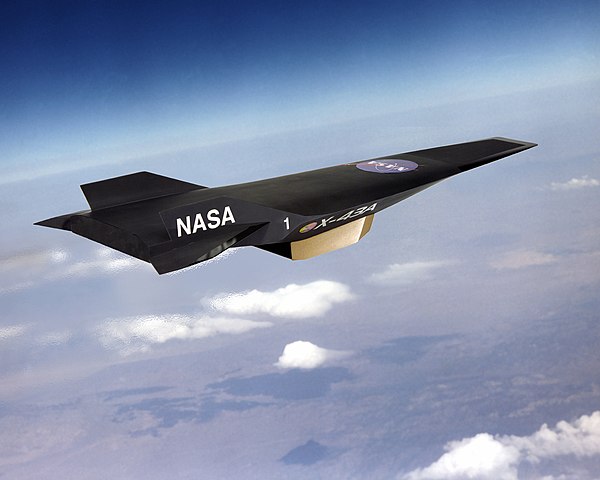
What is a Scramjet? It is an air breathing jet engine that works at supersonic speeds.
Right. There are three questions we need to unpack here. How does a jet engine work? How does a ramjet engine work? How does a scramjet engine work?
A jet engine has fan turbines at the front of it which spin and suck air into the engine. The turbines force more air into the body of the engine than would normally be able to fit, which compresses the air. The air is compressed to almost seven times atmospheric pressure and it picks up a lot of energy. At the back of the engine, fuel is sprayed into the compressed air and ignited with a spark. The fuel ignites and the burning gas rapidly expands. It has nowhere to go out of the back of the engine, so it explodes outwards with a huge amount of force. As we know from Newton, every reaction has an equal and opposite reaction. The plane is not fastened down and it is pushed forward with the same force that the gas thrusts backwards. We can see this in a gun. When you fire the gun, the gases expand and push the bullet out of the barrel, but the gun is pushed backward with the same amount of force. So, in the jet engine, if you keep compressing air and spraying it with fuel, you will keep going forwards.
The air that enters the jet engine has to be slowed down to about 350 km/h. This is because faster air can blow out the fire at the back of the engine and cause a flame-out. If there is no fire, there is no thrust. Jet engines are perfect for the majority of passenger aircraft because they do not exceed about 900 km/h, which means the air doesn’t have to be slowed down too much. However, it can be a problem for military aircraft and NASA aircraft because the faster you go, the more energy is needed to slow down the air and the greater the risk of a flame-out. The increased energy heats up the fan turbine blades at the front of the engine and they can break.
A ramjet engine can be used at supersonic speeds because it doesn’t have any turbine blades. However, other than that, it works on pretty much the same principle as the jet engine. The air coming in to the engine still has to be slowed down enough that combustion can take place at the back of the engine. The way that the ramjet slows down the energy is by using the speed of the aircraft itself. The speed of the aircraft causes a shockwave in front of each engine and this slows down the air coming in to the engine. Creating this shockwave reduces the efficiency of the engine because some thrust is lost in that direction. Because of this, ramjets are not very efficient until the aircraft reaches about mach 0.5 and they are most efficient at mach 3. Ramjet engines cannot be used for takeoff because they need air to be moving through the engine and none will be when the aircraft is stationary. This means they have to have a second source of power to take off.
Scramjets are an advance on ramjets because they don’t need to have a shockwave in front of each engine. They can take in air at higher speeds and the air stays at supersonic speeds as it passes through the engine. The whole engine is a modified version of the ramjet and it can withstand the enormous pressures that the air creates. It also has a modified shape and the fuel injectors have been modified to express the fuel and ignite it much faster. The air is passing through so quickly that the fuel needs to be sprayed and ignited in milliseconds. This was one of the biggest problems for the designers of scramjets because a few milliseconds late and the fuel will ignite outside of the engine, producing no thrust. Scramjets are currently used on rockets and some experimental aircraft. They have the same problem as ramjets in that they cannot be used from a static start. They are most efficient at about mach 4. They are usually launched with a different engine or dropped from another plane.
One of the advantages that scramjets have over conventional turbine jets is that they have no moving parts. Regular jet engines have a series of fans, and a whole range of other parts, all of which can break and are heavy. Scramjets are light, have no moving parts, and are very fast. They do produce a huge amount of heat, though. And this is what I learned today.
Sources
https://en.wikipedia.org/wiki/Scramjet
https://en.wikipedia.org/wiki/Ramjet
https://www.nasa.gov/centers/langley/news/factsheets/X43A_2006_5.html
https://www.grc.nasa.gov/www/k-12/UEET/StudentSite/engines.html
https://www.blazingtrails.info/post/anatomy-of-a-jet-engine-the-compressor-section
https://skybrary.aero/articles/ramjet
https://abcnews.go.com/Technology/story?id=98824&page=1
